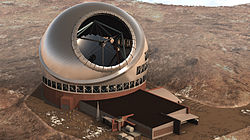Top Qs
Timeline
Chat
Perspective
Extremely large telescope
20-100-m-aperture astronomical observatory From Wikipedia, the free encyclopedia
Remove ads
An extremely large telescope (ELT) is an astronomical observatory featuring an optical telescope with an aperture for its primary mirror from 20 metres up to 100 metres across,[1][2] when discussing reflecting telescopes of optical wavelengths including ultraviolet (UV), visible, and near infrared wavelengths. Among many planned capabilities, extremely large telescopes are planned to increase the chance of finding Earth-like planets around other stars.[3] Telescopes for radio wavelengths can be much bigger physically, such as the 300 metres (330 yards) aperture fixed focus radio telescope of the Arecibo Observatory (now defunct). Freely steerable radio telescopes with diameters up to 100 metres (110 yards) have been in operation since the 1970s.

These telescopes have a number of features in common, in particular the use of a segmented primary mirror (similar to the existing Keck telescopes), and the use of high-order adaptive optics systems.[4][5]
Although extremely large telescope designs are large, they can have smaller apertures than the aperture synthesis on many large optical interferometers. However, they may collect much more light, along with other advantages.
Remove ads
List of telescopes
Remove ads
Budget
Possible budget figures, which are estimates and can vary over time. For construction costs, it is recommended to estimate the cost of a giant telescope with the relation cost ∝ D2.7.[16]
Remove ads
Projects
There were several telescopes in various stages in the 1990s and early 2000s, and some developed into construction projects.
- Under construction
- Funded construction
- Projects
Some of these projects have been cancelled, or merged into ongoing extremely large telescopes.
- GSMT:[22] Giant Segmented Mirror Telescope, merged into TMT
- OWL:[23] Overwhelmingly Large Telescope, passed over in favor of ELT
- VLOT:[24] Very Large Optical Telescope, merged into TMT
- LAT:[25] Large Atacama Telescope
- EURO50:[26] European 50-metre Telescope, merged into ELT
- LPT:[27] Large Petal Telescope
- Magellan 20: merged into GMT
- HDRT:[28] High Dynamic Range Telescope
- JELT:[29] Japanese ELT Project; Japan joined the TMT project in 2008
- CELT:[30] California Extremely Large Telescope, became/merged into TMT
- MAXAT:[31] Maximum Aperture Telescope
See also
References
External links
Wikiwand - on
Seamless Wikipedia browsing. On steroids.
Remove ads








